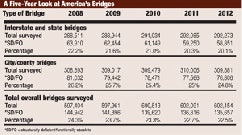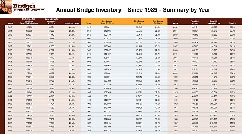Getting Better all the Time
America’s structurally deficient and functionally obsolete 
By Tina Grady Barbaccia
They aren’t numbers to throw a party for yet, but once again, the number of structurally deficient (SD) or functionally obsolete (FO) bridges in America has fallen.
Our propreitary 2012 Bridge Inventory survey of 602,154 bridges shows 22.5 percent in the SD/FO categories, down from 22.7 percent in last year’s survey, 23.3 percent in our 2010 survey, 23.7 pecent in 2009 and 24.3 percent in 2008.
Reponses show 20.1 percent SD/FO bridges among highway and Interstate bridges (down from 20.3 percent last year). Among city and county bridges 24.8 percent fall into the SD/FO category compared to 25 percent in 2011, although the total number of city/country SD/FO bridges has actually fallen (but so has the overall total surveyed).
Pennsylvania has the highest total number of combined (Interstate/highway and city/county) SD/FO bridges (9,095) ahead of Texas (8,752) and Oklahoma (6,547).
Washington, D.C., has the highest percentage of total combined SD/FO bridges at 55 percent, followed by Rhode Island with 49 percent and Pennsylvania with 40 percent.
Arizona leads the good news categories with the lowest percentage of combined SD/FO bridges at 10 percent followed by Nevada at 11 percent and Utah at 13 percent.
But amid cautious optimism arising from this improvement comes word from states that the new two-year, $105 billion, surface transportation legislation, Moving Ahead for Progress in the 21st Century (MAP-21), which has been faintly praised as a mini-savior for America’s transportation infrastructure, still leaves us with a lack of adequate funds, now and in the foreseeable future, and that shortfall is still a major roadblock to a significant decrease in SD/FO numbers.
State Reports
John Orbistondo, engineering assistant for the Alaska Department of Transportation, says funding availability remains the state’s greatest challenge to lowering its rate of deficient bridges and the new transportation bill isn’t going to make much difference. “Having MAP-21 does no favor for bridges except the NHS [National Highway System] focus,” Orbistondo notes in his survey answers. “[It] leaves other bridges underfunded.”

Gary Doerr, bridge management with the North Dakota State Highway Department, also says funding availability is one of the great challenges to lowering the state’s rate of deficient bridges as is “on-local systems.” Although Doerr says the state does expect to lower its rate of deficient bridges this year through “replacements and rehabs,” 10 bridges, all local, have been closed this year because of structural failure or collapse. In the last five years, that number is 120 local bridges. Doerr also points out that MAP-21 won’t make a difference with his agency’s ability to repair bridges. “A two-year bill does not provide the long-term planning avenue,” he says.
But state agencies are not allowing the lukewarmth of MAP-21 derail them.
For example, Mills Gotcher, Oklahoma Department of Transportation media and public relations representative, tells Better Roads that although funding availability remains the state’s greatest challenge in lowering bridge deficiency rates, MAP-21 “offers more funding flexibility and stability to deliver our bridge program. The emphasis on bridge preservation has resulted in a dramatic improvement in the condition of the on-system bridges.”
In fact, Oklahoma has embarked on an ambitious journey that started in 2002 with a $5.5 billion highway and bridge improvement program that will address all of Oklahoma’s deficient bridges by the end of 2020, following the Sept.10 approval by the Oklahoma Transportation Commission of the Federal Fiscal Year 2013 eight-year construction work plan. The program includes “all on-system known SD bridges be addressed by 2020,” Gotcher says. “A significant portion of these bridges are included for the coming year.”
In the past year, one bridge has been closed in Oklahoma because of structural failure or collapse and four have been closed in the last five years. All increased funding proposed by Oklahoma Governor Mary Fallin’s “Bridge Improvement and Turnpike Modernization Plan,” which was approved by the state legislature in May and signed by Fallin, means the eight-year plan includes the replacement or rehabilitation of the remaining 634 SD highway bridges. The plan includes 2,030 total projects and 951 bridge replacement or major rehabilitation projects.
“This will ensure that the number of structurally deficient bridges on state-owned highways, which peaked at 1,168 in 2004, will be essentially eliminated by the end of the decade,” says Oklahoma DOT Secretary Gary Ridley. “After decades of major bridge problems, Oklahomans will finally have a safe and reliable bridge network that meets the needs of our growing state, and one for which we can all be proud.”
Gotcher adds, however, that if one aspect of Oklahoma DOT could be changed to improve bridges, it would be to add more bridge inspectors and program managers. Additional qualified personnel would help keep our inspectors current and further improve the quality. The supply of qualified personnel falls short of the inspection demands.”

The West Virginia Department of Transportation does not foresee lowering its rate of deficient bridges in the coming year. Insufficient funding will defer important work, according to W. Kyle Stollings, director of the maintenance division for West Virginia DOT. However, he does say that MAP-21 “stabilizes the planning process.”
The California Department of Transporation, commonly known as Caltrans, often leads the way in trends and thought within the industry. The agency believes that MAP-21’s two-year commitment of funds gives Caltrans and local agencies “a measure of certainty needed to plan and deliver bridge improvement projects,” says Matt Rocco, Caltrans media relations manager. He says that in the short term, through fiscal year 2012-2013, no major changes to project funding is anticipated. “However, MAP-21 includes performance and accountability requirements, which in the long term, could affect schedule and funding decisions for bridge and highway improvement projects,” Rocco says. Caltrans does not “anticipate that funding constraints will affect priority safety projects.” Caltrans invests about $450 million each year to protect and preserve state-owned bridges, Rocco says.

For the short-term outlook, says Cody Axlund, bridge inventory/inspection engineer for the South Dakota Department of Highways, “MAP-21 has helped our discussion for bridges on the National Highway System. For all other bridges within our state, MAP-21 has added to uncertainty of available funding since it eliminated a dedicated funding pool for bridges.”
Bridges now need to compete against all other federal aid eligible expenses for the funding, Axlund notes. “Fortunately for our local governments, in South Dakota, our Transportation Commission has elected to continue with the same allocation for available bridge funds for Fiscal Year 2013 and Fiscal Year 2014 as was used in Fiscal Year 2012 with a minor percent adjustment as was received in all STP funds for South Dakota,” he says. “The uncertainty continues since MAP-21 is only a two-year bill, and we are now underway with try to program and begin design for Fiscal Year ‘15 structures.”
Minnesota reports that only 14 percent of its combined total bridges are SD/FO (tied for fourth-best in the nation with Wyoming and Wisconsin). That’s 1,856 of the state’s total 13,735 bridges. The state’s total Interstate and state bridges is also tied with Iowa and South Dakota at 9 percent for having the fourth-lowest percentage of SD/FO bridges. North Dakota has lowest percentage of total interstate and state bridges that are SD/FO with only 5 percent meeting this definition. Wyoming comes in second-lowest with 6 percent (14 percent of all bridges in the state are SD/FO) rated as SD/FO. Nebraska has the third-lowest with only 8 percent (23 percent of all bridges in the state are SD/FO) meeting the SD/FO classification.
The Minnesota Department of Transportation (MnDOT) is “committed to managing a safe system of bridges in Minnesota,” Thomas Martin, bridge data management, Minnesota DOT Bridge Office, tells Better Roads. The state expects to be able to lower its rate of deficient bridges in the coming year, he says, with “dedicated state funds and bonds for F/C [fracture critical] and deficient bridge replacement and rehabilitation projects.
“Keeping bridges in a state of good repair is a funding priority, and in 2008 the Minnesota State Legislature established a 10-year program to address structurally deficient and fracture critical bridges,” Martin says. “State bond dollars, along with federal dollars, fund this state highway bridge repair and replacement program. Having a new reauthorization bill will assist MnDOT in our assumptions of the level of federal funding that will be available to us in the next two federal fiscal years.”
Wayne J. Seger, P.E., Division of Structures, Director, with the Tennessee Department of Transportation Bridge Inspection/Repair Office, says the agency is “focused on structurally deficient bridges in the inventory for replacement and/or repair to retire the deficiency.” Of the 15 bridges closed in Tennessee in the past five years and one this past year because of structural failure or collapse, “all have been or are being replaced or repaired,” Seger says. “We had a major flood in middle and west Tennessee in May 2010. It forced us to close 54 bridges. However, in most of these cases, it was the approach roadways that had washed out.” Only 10 bridges needed to be closed due to structural damage or complete washout, which are the 10 included in the 15 the state listed as those there were in imminent danger of collapse or had already collapsed or had been taken out by a flood, he says. “We have had many more that had been closed following an inspection due to deterioration in an element or elements that thorough evaluation would not support at least three tons,” Seger says. “These were closed, and in most cases, the owner would repair the deteriorated member so that the structure could be put back into service.”
Seger points out that most of the state’s bridge repair projects are 100-percent state funded, and says that “MAP-21 will allow other types of transportation projects to compete for potential bridge funds.”
However, Adam Matteo, assistant bridge engineer with the Virginia Department of Transportation, says the new bill actually “hurts” his agency. “There are not ‘BR’(bridge replacement)funds, and therefore no requirement to fund bridges,” Matteo says.
Nick J. Altobelli, P.E., director of structures state bridge engineer with the Mississippi Department of Transportation, thinks MAP-21 is less restrictive on applying funds, but there are “too many needs pulling from the same source.” Gregory R. Perfetti, P.E., state structures management engineer with the North Carolina Department of Transportation, says with MAP-21, “it appears that there will be increased flexibility in [the] use of available funds.” David Fish, P.E., managing engineer with the Rhode Island Department of Transportation, says it may help “by drawing attention to SD bridges.”
Steve Anderson with the Nebraska Department of Roads Bridge Division, points out that while the legislation “improves the stability of funds,” the new requirements “will again syphon off money needed for construction. We always have more need than funds.”
David E. Powelson, P.E., chief, existing bridge section, New Hampshire Department of Transportation, says that MAP-21 “provides more consistent funding that continuing resolutions, allowing better long-term planning.” But, he says, it’s important to note that the nation still needs a major overhaul when it comes to “sufficient revenue and funding to support full infrastructure reconstruction and investment.” What makes this even more difficult, Powelson, says is that “the traveling public does not fully understanding nor choose to fund the work required to address bridge deficiencies.”
Harvey L. Coffman, P.E., bridge preservation engineer with the Washington Department of Transportation Bridge Preservation Office, simply says MAP-21 will make “no difference.” He also notes that “more resources, [a] priority to maintain [and] preserve infrastructure” are needed in the system of planning and maintaining bridge as in the United States at the federal, state and local level.”
Eric J. Christie, assistant state maintenance engineer – bridges, Alabama Department of Transportation, agrees with Coffman, noting that MAP-21 “will not make a difference” with his agency’s ability to repair bridges. John D. Clark, state bridge maintenance and repair engineer with the Florida Department of Transportation, says “No, No” when commenting on if MAP-21 will make any difference with his agency’s ability to repair bridges.
The New Mexico Department of Transportation is still up in the air as to whether the short-term highway bill will have any impact on the agency. “We are not sure at this time,” Jeff C. Vigil, P.E., state bridge management engineer for the New Mexico DOT Bridge Maintenance Unit, said when he answered the Better Roads 2012 Bridge Inventory survey in late September/early October. “It will depend on how funding is prioritized.” Vigil also acknowledges that insufficient funding will restrict important work in the coming year to “a major extent.” He also notes that “larger and more consistent funding levels” are needed” for the system of planning and maintain bridges in the United States at the federal, state and local levels.
State DOT Wish Lists
“If you could change any aspect of your department to improve your bridges, what would it be?”
Georgia: “Georgia’s on-system bridges basically are in good condition, but aging. Long-term sustainable funding that would allow a more robust and expansive rehabilitation and replacement program would be welcome.” — Ben Rabun, P.E., state bridge maintenance engineer, Georgia Department of Transportation
Kansas: “Bridge management for long-term maintenance – realizing the value of preservation actions.”
— Calvin Reed, P.E., Kansas Department of Transportation, bridge management engineer
Kentucky: “Allocate more resources dedicated to preventive maintenance on bridges. Design and construct maintenance-friendly bridges. It costs less to keep up with the needed maintenance than it does to wait untl the bridge becomes deficient and then spend funds.” — David Steele, branch manager, Kentucky Transportation Cabinet, Division of Maintenance
Minnesota: “A sustainable funding source for bridge preservation, rehabilitation and replacement programs.” — Thomas Martin, bridge data management, Minnesota Department of Transportation Bridge Office M S 610
Missouri: “More funding. The lack of funding is a problem for all aspects of our transportation system within our state.” — David Koenig, P.E., bridge structural service engineer, Missouri Department of Transportation
New Jersey: “Need to expand on [a] preventive maintenance program. Many bridge issues [are] due to deck joints drainage systems [and] salt intrusion.” — Eli D. Lambert, P.E., New Jersey Department of Transportation
North Dakota: “Is a deck rating of 4 really as critical as super = 4? Few bridges have catastrophic failure because of decks.” — Gary Doerr, North Dakota State Highway Department, bridge management
South Carolina: “Less bureaucracy.” — Lee Floyd, South Carolina Department of Highways, bridge maintenance engineer
Texas: “It would be to implement a dedicated bridge maintenance program. this would reduce the number of SD and FO bridges and help maintain that bridge currently in good or better condition. — Alan Kowalik, P.E., Texas Department of Transportation, bridge inspection engineer
West Virginia: More bridge maintenance and evaluation engineers to improve oversight planning and maintenance. — W. Kyle Stollings, West Virginia Department of Transportation, director of Maintenance Division
Wisconsin: “More emphasis on preventive maintenance…preservation of the infrastructure.” — Travis McDaniel, P.E., Wisconsin Department of Transportation












